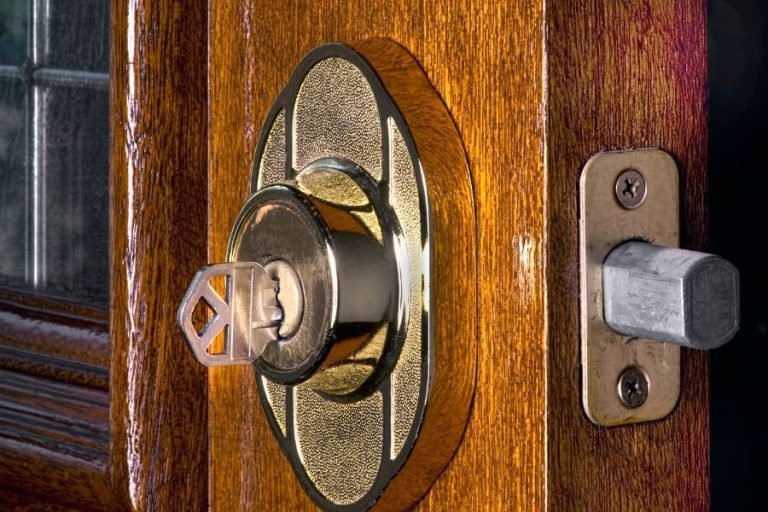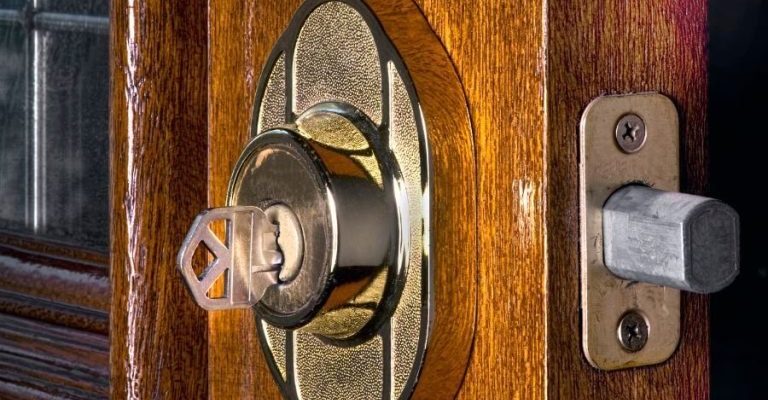
So, what’s really going on when the outside part of your deadbolt—the cylinder where you insert the key—starts fighting back? Whether you own a classic Schlage, Kwikset, Yale, or another well-known brand, a sticky cylinder is a clue that something isn’t working as it should. Sometimes, fixing it is quick and easy. Other times, it might hint at a deeper problem with your lock, door, or even your key itself. Let’s get to the bottom of why your deadbolt’s exterior cylinder is hard to turn, and what you can do about it.
What Makes a Deadbolt Cylinder Get Stiff or Stuck?
Honestly, a deadbolt cylinder should turn as easily as clicking a remote. When it doesn’t, something is blocking its smooth movement. A lot of folks think it’s always the lock itself, but there are several possible culprits.
First, everyday dirt and dust love to sneak inside the tiny grooves and pins of your lock cylinder. Over time, this grime can act like sand in your gears, making each turn feel gritty and difficult. Sometimes, even a small speck can stop a high-quality Kwikset or Schlage deadbolt in its tracks.
Another big reason? Lack of proper lubrication. Just like any bit of machinery, your deadbolt needs a little help to keep moving parts gliding smoothly. If it’s been ages since your lock saw any lock lubricant (preferably graphite, not WD-40), you can bet things are getting sticky inside.
Let me explain: Sometimes, it’s not the lock but the *alignment* of your door. If the deadbolt and the strike plate (the metal bit on the frame) don’t line up just right, the cylinder can feel jammed, especially as weather or house settling cause things to shift. So, before blaming the lock, check for door sagging or frame warping.
Common Causes for a Hard-to-Turn Deadbolt Cylinder
Here’s the thing: Most deadbolt problems boil down to a handful of usual suspects. Let’s look at what might be making your exterior cylinder tough to turn.
- Dirt and Debris: Outdoor locks face the elements. Rain, wind, and dust can introduce tiny bits of dirt inside your cylinder. Over time, this builds up and gums up the works.
- Lack of Lubrication: If your lock feels “dry” or squeaky, that’s a red flag. Locks need special lubricants (like graphite powder or dry Teflon sprays) to keep tumblers moving freely.
- Worn or Damaged Key: You might be wondering if your key is the problem. A bent, dirty, or worn-down key can’t sync up with the lock pins, making your cylinder hard to turn. Try a spare key: If it works better, you’ve found your culprit.
- Misaligned Door or Strike Plate: When a door swells, sags, or gets out of alignment, the deadbolt bolt can jam against the strike plate, making the cylinder tough to turn—even if the lock itself is fine.
- Internal Lock Wear: Deadbolts see a lot of action. Pins, springs, or the cam mechanism inside can wear down, making the turning motion stiff or clunky. Some brands, like Yale or Schlage, tend to last longer, but no lock lasts forever.
Let’s say you just installed a new lock, and it’s still hard to turn. Don’t rule out a manufacturer defect or installation issue. Even brand-new hardware isn’t immune to problems.
How Key and Cylinder Work Together Inside Your Deadbolt
To understand why your deadbolt’s cylinder is hard to turn, it’s helpful to peek under the hood—figuratively. The exterior cylinder is where the “magic” of a lock happens.
When you slide your key into the cylinder (like a Schlage or Kwikset), the features cut into your key interact with a precise row of pins inside. The correct key lifts each pin to the right height, letting you rotate the cylinder and open the lock. If anything interrupts this smooth dance—debris, old grease, or a misshapen key—the cylinder can seize up.
There’s one more thing: If you’ve ever tried to pair a new key by re-keying your cylinder (common with universal or “smart” locks), a mistake in the reassembly can create resistance, too. It’s almost like a poorly written bit of code—one small error jams up the works for everyone.
So, if your lock is older, has seen a few key resets, or hasn’t been cleaned in ages, the cylinder could be ripe for trouble. A well-maintained deadbolt will feel almost effortless to turn.
How Weather and Environment Affect Your Lock Cylinder
You might not think about the weather’s role in your deadbolt’s stubbornness, but it absolutely matters. Outdoor cylinders are constantly exposed to swings in temperature, moisture, and direct sunlight.
During cold months, metal contracts. If your deadbolt cylinder gets chilled, the inside pins and springs can shrink, sometimes making the lock feel tight or frozen. On the flip side, humidity can cause your door to swell or even trigger rust inside the cylinder’s smallest parts. Let me tell you, a lock that’s sat through a soaking rainstorm—or survived a few winters—can get sticky fast.
There’s also the problem of “freeze-thaw” cycles. Any moisture trapped inside a cylinder can freeze solid overnight, making your key almost impossible to turn until things thaw out. This is especially common with exterior deadbolts on garage doors, gates, or back entries.
Aside from temperature, salty air (hello, coastal cities!) is a notorious enemy of lock cylinders, speeding up corrosion and gumming up tumblers. If your area sees a lot of rain, snow, or ocean spray, it’s smart to give your lock some extra care.
Step-By-Step Troubleshooting for a Hard-to-Turn Deadbolt Cylinder
Here’s a straightforward routine if your deadbolt cylinder won’t budge:
- Test with a Spare Key: Start simple. Try a backup key. If it works better, your main key might be worn or bent.
- Look for Visible Gunk: Shine a flashlight into the cylinder. If you spot dirt or buildup, it’s time for cleaning.
- Apply Lock Lubricant: Squirt a little graphite powder (never grease or oil) directly into the cylinder. Push your key in and out a few times to work it in, then try turning again. Lubrication should always be dry to avoid attracting more dirt.
- Check Door Alignment: Open the door and try turning the deadbolt. If it feels smooth when open, but tough when closed, your strike plate or frame may need adjusting. Tighten screws or adjust the plate if possible.
- Inspect for Rust or Corrosion: Any greenish or reddish crust around the cylinder needs attention. Rust can lock up the mechanism and may need more serious cleaning or part replacement.
- Reset or Re-Key If Necessary: For those handy with tools, re-keying can solve internal pin issues—especially after lost keys or attempted break-ins.
If you’ve walked through all these troubleshooting steps and it’s still tough to turn, your lock’s interior components might be worn out. In that case, a replacement is likely your best bet.
When Should You Replace vs. Repair a Sticky Deadbolt Cylinder?
Choosing between a quick fix and a full-on replacement isn’t always obvious—especially if you’re new to home hardware. Here’s what I’d consider if the exterior cylinder is still hard to turn after cleaning and lubricating.
If your lock is older, showing signs of rust, or the key feels loose or rough even after cleaning, those are hints the inner pins or springs are shot. Sometimes, a worn cylinder can trap your key or even stop you from unlocking the door, which is never a fun surprise late at night.
On the other hand, if your lock is fairly new (maybe a recent Schlage or Kwikset), and the issue popped up suddenly, you might just need a deeper sync—meaning a full clean, lubrication, or a quick re-key. Some universal lock kits let you swap cylinders without replacing the whole set. That way, you keep your exterior hardware and just reset the mechanism itself.
A good rule? If you’ve tried all the basic troubleshooting and the lock is still unreliable—or if security is a concern—don’t risk it. Replacing the deadbolt cylinder is usually quick, affordable, and restores confidence that your home is secure.
Preventive Tips to Keep Your Deadbolt Cylinder Turning Smoothly
Prevention’s always easier than rescue. Keeping your deadbolt’s exterior cylinder happy doesn’t take much—just a little ongoing attention.
- Lubricate Every 6–12 Months: Sprinkle graphite powder or a lock-specific dry spray inside the cylinder. Avoid greasy sprays that attract dust.
- Wipe Keys and Lock Face: A quick wipe with a cloth removes grime that can migrate inside when you insert your key.
- Check Door and Frame Alignment: If your door sticks, sags, or shows daylight around the edges, adjust hinges or the strike plate sooner rather than later.
- Protect From Weather: For doors exposed to rain or snow, consider a small lock cover to block out excess moisture.
- Use Keys Gently: Don’t force a stubborn key. Forcing can bend the key or damage pins, making future lockouts more likely.
Staying on top of these little tasks means you’ll avoid the bigger headache of a totally stuck deadbolt down the line.
Alternatives: Should You Consider a Keyless or Smart Deadbolt?
You might be tempted to throw up your hands and search for a “reset” button, like you would on a remote. If you’re tired of old-school keys and sticky cylinders, it could be time to think about a keyless or smart deadbolt upgrade.
Modern keyless deadbolts use codes, fingerprints, or even your smartphone to control your lock. Models from brands like Schlage, Yale, or August let you skip keys entirely—and you’ll never have to deal with stuck exterior cylinders again. Some even have backup keys in case you need to override the electronics or reset the system.
Here’s a quick comparison for folks on the fence:
| Traditional Deadbolt | Smart / Keyless Deadbolt |
| Uses physical key, can jam or wear | Code, app, or fingerprint—no key needed |
| Low tech, simple to fix | Needs battery, more troubleshooting if electronics fail |
| Can re-key easily | Can reset or pair new users quickly |
| Affordable, fits most doors | Higher upfront cost, but more convenience |
If you like the classic feel of a key, stick with regular deadbolts—but stay on top of maintenance. If you’re ready for a tech upgrade, smart deadbolts offer a different kind of reliability (and fewer sticky cylinders).
Sometimes, the best fix is prevention—and knowing when to let go of stubborn hardware. There’s no shame in upgrading if your lock keeps misbehaving.
Wrap-Up: Getting Back to a Smooth-Turning Deadbolt Cylinder
A hard-to-turn deadbolt cylinder can be more than a daily annoyance—it’s a sign that your home’s first line of defense needs a little attention. Whether the culprit is dirt, weather, poor alignment, or a well-worn key, most issues can be traced, troubleshooted, and fixed with some patience. Sometimes, a bit of simple maintenance goes a long way; other times, it’s smart to cut your losses and replace a stubborn cylinder.
Whatever route you take, remember: a smooth, easy-turning deadbolt isn’t just about convenience—it’s about keeping your home safe and stress-free. With a little care, your lock will keep you secure and save you the embarrassment of getting stuck outside, key in hand.
